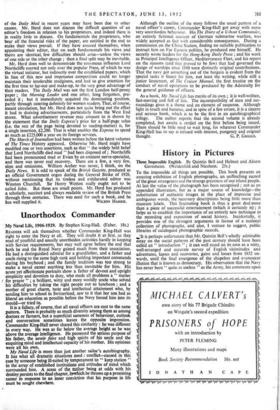History in Pictures
Those Impossible English. By Quintin Bell and Helmut and Alison Gernsheim. (Weidenfeld and Nicolson. 25s.)
To the impossible all things are possible. This book presents an amazing exhibition of English photographs, an unflinching record of the great strangeness and the strange greatness of our island people. At last the value of the photograph has been recognised ; not as an appended illustration, but as a major source of knowledge—the substitution of authentic images in the place of imprecise and ambiguous words, the necessary descriptions being little more than museum labels. This fascinating book is thus a great deal more than a piece of successful entertainment (which it certainly is) ; it helps us to establish the importance of an entirely new technique in the recording and exposition of social history. Incidentally, it provides one of the strongest arguments in favour of a national collection of photographs, and also, I venture to suggest, public libraries of catalogued photographic records.
„,,It is perhaps unfortunate that Mr. Quint in Bell's wholly admirable essay on the social patterns of the past century should have been called an" introduction " ; it can well stand on its own as a witty, well-arranged and accurate survey of English vicissitudes and adventures, lapses and recoveries, gains and losses from 1852 on- wards, until' the final emergence of the shapeless and evanescent illusion that is known as democracy. His observation that the Navy has never been" quite as useless "as the Army, his comments upon Victorian prudery, and his definition of the Edwardian age as a period, of " social disintegration," are splendidly provocative. Of the 201 photographs which form this magnificent collection, none is uninteresting, many are brilliant and some are fantastically beautiful. The earliest examples are three portrait-groups by Octavius Hill dated 1845, and the last is a charming aerial view of the new town of Stevenage in a morning mist (1951) ; it reminds one of a delicate water-colour by Chiang Yee. One of the most delightful of the purely social studies is Roger Fenton's view of Harewood House (1860), where the figures in the formal terraced garden harmonise graciously with a wide and lovely prospect of water, bills and woods .A The vagaries in fashion very naturally provide some of the most astonishing illustrations of the social complex, from the noble sweep of the crinoline to the fore-and-aft rotundities of Miss Camille Clifford and the cylindrical elegance of 1928. What is observable, too, is the fashion in faces, both male and female and in all classes alike : a strange phenomenon which everyone must have noticed but which nobody has endeavoured to explain. As a high- society example of this phenomenon one may profitably study the dreadful tableau vivant by Mrs. Cameron of" The Passing of Arthur," and another, tableau at Osborne by Hughes and Mullins.
Then we have some historical photographs : two of Fenton's Crimean pictures (by no means the best of them), Gladstone election- eering in 1885, Mr. Churchill watching the lamentable affair in Sydney Street in 1911, Mosley and his blackshirts in 1936, tanks for Russia in 1941 (when our enthusiasm for Stalin was unbounded), and a few somewhat reticent pictures of the two World Wars. Perhaps one may regret the absence of any examples of the fine cartes-de- visite of Silvy and Sarony ; indeed, the carte does not seem to be represented at all, unless in a greatly enlarged form. And although the short comments which accompany the pictures are very much to the point, some additional information might have been welcome to the young folk of today. However, the book is entirely delightful, and I cannot imagine a more gratifying present for anyone. We are all of us fascinated by pictures, and this is one of the most enthralling of all the picture-books which have ever been published.
C. E. VULLIAMY.



































 Previous page
Previous page